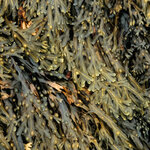Technology

In early July, Karolinska University Hospital issued a press release about a successful trachea transplant using synthetic tissue. It got mainstream media coverage and it was interesting, I thought, but evolutionary and not revolutionary. We had covered a Lancet paper on much the same thing in 2008. But in the course of a correspondence with a media rep she noted something important; not only was this not a traditional transplant, this was not even one where an organ was decellularized and recellularized with the patient's stem cells, it was created for the patient and in…
Devices that monitor the human body's processes are being researched and tested for biological sensing or for prosthetics but materials scientists at the University of Washington have taken that a step farther. They have built a transistor that uses protons and could communicate directly with living things. But the current prototype has a silicon base and could not be used in a human body, so don't get prepared to cyberpunk yourself just yet.
Currently sensing technology typically uses electrons, negatively charged particles, rather than protons, which are positively charged hydrogen…

Apollo 11 and giant leaps for mankind get all the love now but the missions leading up to it brought their own excitement - and a mystery.
In May 1969, two months before man walked on the Moon, Commander Thomas Stafford, Command Module Pilot John Young and Lunar Module Pilot Eugene Cernan made a 'dummy' run and successfully returned from the Moon and landed their Apollo 10 command module, dubbed 'Charlie Brown', in the ocean, after setting a still-existing human speed record of 25,000 MPH. They basically did everything except land on the Moon.
Since they didn't actually land, the…
A retrovirus enzyme whose configuration had stumped scientists for more than a decade has been solved by researchers who called on the participatory cornerstone of Science 2.0 for help.
A group of scientists who wanted help piecing together the structure of a protein-cutting enzyme from an AIDS-like virus challenged players of the online protein folding 'game' Foldit, created by computer scientists and the protein structure lab of biochemist Dr. David Baker at the University of Washington Center for Game Science. The science gamers 'solved' it in only three weeks.
This class of…

Recently there appeared a Science 2.0 Article Algae-Based Polymer May Boost Li-Ion Battery Performance, and shortly afterwards I got an email drawing my attention to what I thought was the same work, but in fact is a different piece of work, from Leeds University,
Polymer Batteries for Next Generation Electronics
If it takes off, Li-ion batteries should become cheaper, lighter, and safer. You can hear the head of the Leeds group, Ian Ward, talking about it on http://www.bbc.co.uk/programmes/b013qzps. It lasts from minutes 8 to 14 of the broadcast: the first item is about…

A 3-D inkjet printer can generate 3-dimensional solids from a wide variety of materials very quickly by applying the material in layers of defined shape and then bonding these layers are with UV radiation. It can create microstructures but 3-D printing technology is still too imprecise for the fine structures of capillary vessels.
Perhaps not for long.
Researchers at Fraunhofer are applying new techniques and materials to come up with artificial blood vessels in their BioRap project. In the future that may mean artificial tissue and maybe even complex organs in future.
There were…

Deep Web Interferometry compares curves in trendlines from synchronized multiple data sources. Interferometric analysis of Web metrics data increases the clarity of meaningful data points by isolating events. For example, given two Websites that track a popular sport, one Website may experience a weekly peak in traffic on Monday and the other site may have two smaller peaks on Wednesday and Saturday. However, during a major tournament both sites experience sharp peaks during the games. These game-driven data spikes appear in both sites' trendlines.
We view event…

The Sheriff of Nottingham will be pleased. It only took 800 years, but poachers can now be tracked down through tests for human DNA on deer remains, according to research led by scientists at the University of Strathclyde.
Aside from being silly, since most 'poachers' are actually just poor people feeding a family, just like they were in Robin Hood's day, identifying deer poachers can be problematic because these 'crimes' are not discovered until long after the event - and no one cares. These 'poachers' also field dress the deer carcass (hunters wear gloves) so little human DNA is left…

The universe I see when I sit on my porch and look up into the sky is very different from the universe a professional astronomer sees with all of today's available advanced technology. On a clear night I may be able to see a few galaxies. On any night astronomers around the world may be counting billions of galaxies.
There are similar differences in the scales by which we measure the Web. Most Websites use some sort of routine analytics reporting tool. Even if you create a blog on Wordpress.com you can get some basic statistics, including lists of Websites that send…

The Encyclopedia of Life (EOL), a free, online collaborative tool, is expanded in its second edition released today, offering information on more than one-third of all known species on Earth.EOLv2 has 20 times as many pages as when the EOL.org first launched in 2008 - 700,000 today. The global partnership of 170 content providers behind EOL.org wants to build a site with 1.9 million pages, one for every species known to science. With the new interface, users can more easily find species of interest, create personal virtual collections of photos and information, find or upload…